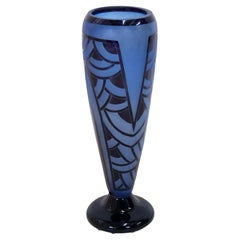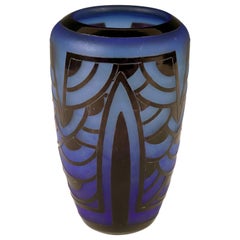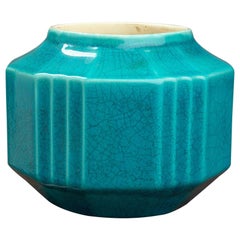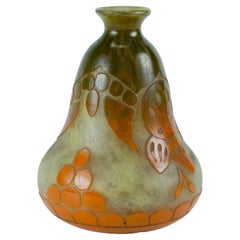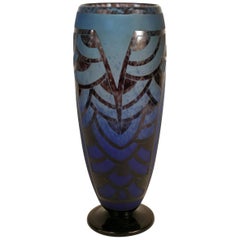Schneider Nenuphar
Early 20th Century French Art Deco Vases
Glass
Early 20th Century French Art Deco Vases
Art Glass
People Also Browsed
Vintage 1930s Belgian Art Deco Vases
Ceramic
Vintage 1920s French Art Deco Glass
Art Glass
Vintage 1930s Belgian Art Deco Vases
Enamel
Early 20th Century French Art Nouveau Vases
Glass
Vintage 1920s Italian Art Deco Wardrobes and Armoires
Steel
Early 20th Century French Art Nouveau Vases
Glass, Art Glass
Vintage 1930s French Art Deco Vases
Ceramic
Vintage 1920s French Art Nouveau Glass
Art Glass
Vintage 1920s French Art Deco Vases
Art Glass
Vintage 1920s French Art Deco Mantel Clocks
Art Glass
Vintage 1920s French Art Deco Glass
Art Glass
Vintage 1930s French Art Deco Vases
Glass
Vintage 1930s American Art Deco Musical Instruments
Metal
Vintage 1910s French Art Nouveau Vases
Art Glass
Vintage 1910s French Art Nouveau Glass
Art Glass
20th Century French Art Deco Club Chairs
Velvet, Mahogany
Recent Sales
Vintage 1920s French Art Deco Vases
Art Glass
Charles Schneider for sale on 1stDibs
The Schneider Glassworks (Verreries Schneider), established by brothers Charles and Ernest Schneider in Epinay-sur-Seine, France, in 1917, was among the leading producers of fine-art glass between the two world wars, creating exuberantly colorful vessels and lighting fixtures in both the Art Nouveau and Art Deco styles. The factory’s highpoint was the 1920s, when it created iconic chandeliers and exquisitely decorated cameo glass vases that are still in high demand today.
Born in the last quarter of the 19th century in Château-Thierry, near Paris, Charles and Ernest Schneider moved with their family at a young age to Nancy, a major center of Art Nouveau design, particularly known for glass. Among the city’s master makers was the crystal studio Daum, where both brothers worked at the turn of the 20th century, Ernest in sales, and Charles receiving training in the engraving and decoration workshop, while concurrently learning drawing and modeling with Henri Bergé and attending the École des Beaux-Arts in Nancy. In 1904, he enrolled at the École Nationale Supérieure des Beaux-Arts, in Paris, where he studied painting and metal engraving and regularly showed in the engraving section of the Salon de la Société des Artistes Français, twice receiving a prize.
Around 1912 the brothers and their friend, architect Henri Wolf, bought a small glass factory specializing in lightbulbs, renaming it Schneider Frères et Wolff. The partners enticed a group of about 20 workers from the Daum workshop to join the company, which produced high-quality cameo vases and lamps until the outbreak of World War I, in 1914, when Charles, Ernest and most of the workers were called up to fight. The Schneiders were demobbed in 1917 and reopened the factory, initially making practical glassware for hospitals. After the war, to fund their reentry into the art-glass market, they sold shares in the company, now named the Société Anonyme des Verreries Schneider. The success of the elegant drinking glasses and Art Nouveau-style cameo vases they produced allowed the brothers to buy back the shares, at which point they renamed the factory Verreries Schneider.
When a fire destroyed the Gallé studios in 1918, the Schneiders offered space to a group of the company’s artists so they could continue production. In return, they taught Charles marqueterie de verre. Similar to wood marquetry, this process involves cutting sections out of a glass surface and filling them with pieces of a contrasting color. In 1921, Schneider trademarked his technique for making cameo glass lamps and vases — exemplified in this piece from the early 1920s — which he signed “Le Verre Français” or “Charder,” the latter perhaps a portmanteau combining his first and last names. These works were popular and sold well at France’s top department stores, including Galeries Lafayette and Le Bon Marché. More elaborate, one-of-a-kind pieces from the studio were signed “Schneider” and offered at Paris art galleries like Au Vase Etrusque and Delvaux.
The Schneiders participated in the 1925 Exposition Internationale des Arts Décoratifs et Industriels Moderne in Paris, at which Charles was a member of the jury. The company was at its peak, expanding both its design repertoire and the number of workers, to 500. During this period, it began moving away from the organic shapes of Art Nouveau to the more geometric designs of Art Deco, with some pieces embodying a kind of transitional style, such as this chandelier. Charles also began experimenting with pigmented powders, fine crushed glass mixed with metal oxides, which yielded brilliant, iridescent colors when applied to a glass surface.
A large portion of the factory’s art glass production was sold in the United States. When the U.S. stock market crashed in 1929, demand was all but obliterated, and the company struggled to stay afloat throughout the 1930s. Ernest died in 1937, and during World War II, the factory was seized by German troops and used as a canteen. In 1950, Charles and his son set up a new factory called Cristalleries Schneider in Epinay-sur-Seine, which for several years produced free-blown glass vases, small sculptures and lighting fixtures to some acclaim. Charles Schneider died in 1952, and the factory eventually closed in 1981.
A Close Look at art-deco Furniture
Art Deco furniture is characterized by its celebration of modern life. More than its emphasis on natural wood grains and focus on traditional craftsmanship, vintage Art Deco dining chairs, tables, desks, cabinets and other furniture — which typically refers to pieces produced during the 1920s and 1930s — is an ode to the glamour of the “Roaring Twenties.”
ORIGINS OF ART DECO FURNITURE DESIGN
- Emerged in the 1920s
- Flourished while the popularity of Art Nouveau declined
- Term derives from 1925’s Exposition Internationale des Arts Décoratifs et Industriels Modernes (International Exhibition of Modern Decorative and Industrial Arts) in Paris, France
- Informed by Ancient Egypt, Cubism, Futurism, Louis XVI, De Stijl, modernism and the Vienna Secession; influenced Streamline Moderne and mid-century modernism
CHARACTERISTICS OF ART DECO FURNITURE DESIGN
- Bold geometric lines and forms, floral motifs
- Use of expensive materials such as shagreen or marble as well as exotic woods such as mahogany, ebony and zebra wood
- Metal accents, shimmering mirrored finishes
- Embellishments made from exotic animal hides, inlays of mother-of-pearl or ivory
ART DECO FURNITURE DESIGNERS TO KNOW
VINTAGE ART DECO FURNITURE ON 1STDIBS
Few design styles are as universally recognized and appreciated as Art Deco. The term alone conjures visions of the Roaring Twenties, Machine Age metropolises, vast ocean liners, sleek typography and Prohibition-era hedonism. The iconic movement made an indelible mark on all fields of design throughout the 1920s and ’30s, celebrating society’s growing industrialization with refined elegance and stunning craftsmanship.
Widely known designers associated with the Art Deco style include Émile-Jacques Ruhlmann, Eileen Gray, Maurice Dufrêne, Paul Follot and Jules Leleu.
The term Art Deco derives from the name of a large decorative arts exhibition held in Paris in 1925. “Art Deco design” is often used broadly, to describe the work of creators in associated or ancillary styles. This is particularly true of American Art Deco, which is also called Streamline Moderne or Machine Age design. (Streamline Moderne, sometimes known as Art Moderne, was a phenomenon largely of the 1930s, post–Art Nouveau.)
Art Deco textile designers employed dazzling floral motifs and vivid colors, and while Art Deco furniture makers respected the dark woods and modern metals with which they worked, they frequently incorporated decorative embellishments such as exotic animal hides as well as veneers in their seating, case pieces, living room sets and bedroom furniture.
From mother-of-pearl inlaid vitrines to chrome aviator chairs, bold and inventive works in the Art Deco style include chaise longues (also known as chaise lounges) and curved armchairs. Today, the style is still favored by interior designers looking to infuse a home with an air of luxury and sophistication.
The vintage Art Deco furniture for sale on 1stDibs includes dressers, coffee tables, decorative objects and more.
Finding the Right vases for You
Whether it’s a Chinese Han dynasty glazed ceramic wine vessel, a work of Murano glass or a hand-painted Scandinavian modern stoneware piece, a fine vase brings a piece of history into your space as much as it adds a sophisticated dynamic.
Like sculptures or paintings, antique and vintage vases are considered works of fine art. Once offered as tributes to ancient rulers, vases continue to be gifted to heads of state today. Over time, decorative porcelain vases have become family heirlooms to be displayed prominently in our homes — loved pieces treasured from generation to generation.
The functional value of vases is well known. They were traditionally utilized as vessels for carrying dry goods or liquids, so some have handles and feature an opening at the top (where they flare back out). While artists have explored wildly sculptural alternatives over time, the most conventional vase shape is characterized by a bulbous base and a body with shoulders where the form curves inward.
Owing to their intrinsic functionality, vases are quite possibly versatile in ways few other art forms can match. They’re typically taller than they are wide. Some have a neck that offers height and is ideal for the stems of cut flowers. To pair with your mid-century modern decor, the right vase will be an elegant receptacle for leafy snake plants on your teak dining table, or, in the case of welcoming guests on your doorstep, a large ceramic floor vase for long tree branches or sticks — perhaps one crafted in the Art Nouveau style — works wonders.
Interior designers include vases of every type, size and style in their projects — be the canvas indoors or outdoors — often introducing a splash of color and a range of textures to an entryway or merely calling attention to nature’s asymmetries by bringing more organically shaped decorative objects into a home.
On 1stDibs, you can browse our collection of vases by material, including ceramic, glass, porcelain and more. Sizes range from tiny bud vases to massive statement pieces and every size in between.
